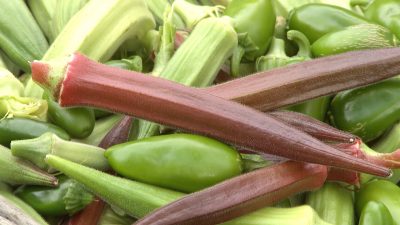Okra

Okra thrives in the heat and is actually quite beautiful, so consider using it as a specimen and edible in the landscape.
Like most of our warm-season vegetables, okra may be planted as both a spring and fall crop. But “fall” here doesn’t equate to what most of us think of as fall. Here in Central Texas, we must plant our “fall” gardens in late July or August, since you’ll need to plant in summer in order to reap a HARVEST in the fall.
There are many great cultivars of okra, but one of my favorites is ‘Burgundy’, which, as its name implies, has deep burgundy fruits, and even quite a bit of burgundy color in the leaves and stems.
Okra requires full sun and minimal, and will do just fine with very little supplemental irrigation, but if you water at least once a week, you’ll get a lot better harvest. An area with well-drained soil is best, and if you’re preparing a new area, it’s a good idea to incorporate about an inch of compost to the bed. As the compost breaks down over time, it improves the structure of the soil, and adds a small amount of nutrients slowly.
Okra will also benefit from a little fertilizer, which you can add after the first harvest to ensure that the plant has plenty of nutrients to produce more fruit.
Okra plants get very tall, so they need plenty of soil depth to anchor themselves. In shallow, rocky soils, they may fall over. Give each plant about a foot on each side to fill in. This fairly narrow width and taller height make okra a nice addition to a spot where you may have had winter annuals that have now died-back. For a list of okra and other vegetables, along with planting times, visit our Travis County website.
categories:
tags:
- August +
- Fall +
- July +
- Vegetables
